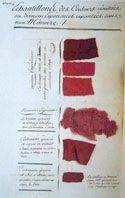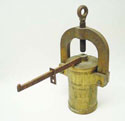Techniques and Innovations
Jean-Baptiste Pont
Making Improvements Viable
1In 1781, Jean-Baptiste Pont wrote to the French Council of Commerce from his home near Carcassonne telling them of his new technique to dye wool red. The special advantage of his discovery was that it used one-third less cochineal than common recipes.1 reference Pont did not wish to establish a colorworks of his own: In exchange for 400 livres, "French industry" could reap all the benefit of his invention. Pont recognized that tests were necessary; he suggested that these take place at the Gobelins' dye works. reference
These comments suggest all we know about Jean-Baptiste Pont. He lived near a provincial city in a region that was the center of the cochineal trade. He was interested in the improvement of trade as a public goal. Pont was probably neither poor nor especially wealthy, although his funds—and his knowledge of chemistry—were enough that he ordered chemical supplies from Paris. The symbolism and sentiment of his request for trials at Gobelins may reflect the institution's stature as a royal manufacture, or it may have been based on an outsider's understanding of the Gobelins' role in developing new dye techniques. reference He may have taught himself chemistry or dyeing, or both subjects; his concern for public utility extended to a petition, as part of his mémoire, for free public courses in dye chemistry throughout the nation. reference Perhaps he was familiar with Louis-Bernard Guyton de Morveau's call for the same, and other efforts to instruct artisans and the public in the chemical foundations of dyeing, agriculture, and metallurgy, but we do not know.2
 Pont's offers were declined at first. He persisted. Eventually his petitions caught the eye of Pierre-Joseph Macquer who was then overseeing dye operations at the tapestry manufacture. In late summer 1782, Macquer asked Pont to clarify and justify aspects of his process; further discussion ensued in which Pont demonstrated his mastery of operational techniques and dye theories. Macquer commented elsewhere that he believed Pont's discovery to be a true discovery, one that could become useful to manufacture. But it was not yet perfected.3
Pont's offers were declined at first. He persisted. Eventually his petitions caught the eye of Pierre-Joseph Macquer who was then overseeing dye operations at the tapestry manufacture. In late summer 1782, Macquer asked Pont to clarify and justify aspects of his process; further discussion ensued in which Pont demonstrated his mastery of operational techniques and dye theories. Macquer commented elsewhere that he believed Pont's discovery to be a true discovery, one that could become useful to manufacture. But it was not yet perfected.3
Cette théorie de la dissolution de la cochenille par l'esprit volatile de sel ammoniac me parait être absolument la même que celle de la dissolution d'indigo par l'acide vitriolique, dont l'action impétueuse, violente et destructrice s'amortit et se perd à mesure qu'il pénétre la matiere grasse résineuse de cet ingrédient, qui dès lors ne lui laisse d'autres faculté que celle d'exercer sur elle une action de combinaison qui est précisement celle que le chymiste, auteur de cette découverte, a vu se proposer dans son opération qu'il n'a faite sans doute qu'à la suite d'une expérience à peu près semblable à la mienne.
J. B. Pont, Mémoire to Macquer and Montaran, 2 October 1782 AN F/12/2259.
Pont submitted the results of the new experiments conducted at Macquer's request in October 1782. More than five months passed before he received a response. Pont continued his work as he waited, making further improvements and submitting additional mémoires to describe the alterations. The initial process to extract more color from cochineal called for the use of volatile spirit of sal ammoniac on the dregs of the typical boiling water extraction. Sal ammoniac was difficult to obtain throughout France in the quantity and quality dyehouses would require; differences between the results obtained from each source for sal ammoniac emphasized the need for standard materials.4 Macquer and Pont considered the sources available; could Antoine Baumé's factory supply more consistently than those of Pia or Capelle?5 Pont's experimentation with other solutions included the addition of tin chloride and spirit of vitriol and such typical dye assistants as alum and urine; each new chemical combination required adjustments to the dye formula. reference reference Another group of experiments used a pressure device (a marmite à Papin) to extract coloring essence. As his expenses mounted, Pont changed his request for remuneration from a single award to an annuity in honor of his discoveries.
 When Macquer died in February 1784, Pont was still improving his improvements. The files passed to Claude-Louis Berthollet, who ended all investigations. While he indicated that Pont deserved praise for his work, Berthollet also believed that the most successful of his innovations would require too many changes to established processes. Their introduction would be impractical at best, and so there was no advantage to continued investigation. A disappointed Pont was offered 200 livres for his work.
When Macquer died in February 1784, Pont was still improving his improvements. The files passed to Claude-Louis Berthollet, who ended all investigations. While he indicated that Pont deserved praise for his work, Berthollet also believed that the most successful of his innovations would require too many changes to established processes. Their introduction would be impractical at best, and so there was no advantage to continued investigation. A disappointed Pont was offered 200 livres for his work.
This episode of invention and improvement illustrates potential pitfalls as well as a trajectory for the acceptance of novelty in commercial and academic circles. A notable feature is the dialogue that developed between the individual and authorities as they worked to encourage and improve manufactures. Yet many projects to improve industry never moved out of the laboratory; difficulties in the transfer of experimental findings into practice proved overwhelming.
Il y a lieu de croire que les manipulations proposées par le Sr Pont, et même quelques additions d'acides qu'il fait dans la 1ère décoction pour tirer plus efficacement la couleur, auraient du succès dans les opérations en grand; cependant comme il le dit lui-même très prudemment, leur utilité ne pourra être bien constatée que dans le travail en grand; les teinturiers seuls décideront des manipulations qui leur seront les plus commodes et les plus avantageuses.
Macquer, Report, 31 October 1782, AN F/12/2259.
Pont's new method to dye cochineal red colors exhibited two problems typical of efforts to improve industry. Access to appropriate materials was essential and one ingredient for Pont's process was an industrial chemical product. Sal ammoniac factories existed but none produced enough to supply all dyehouses in France. The difficulties of transportation also made the use of sal ammoniac too expensive to be practical. In this case, overseeing the quality of an essential chemical assistant was not simply a question of consistency in the product offered by one manufacturing chemist; as Macquer and Pont discussed, expectations of consistency among all chemists were unrealistic. Recognition of these practical problems led to a discussion of the chemical theory behind the extraction process, and this in turn led to experiment with other solutions. A better substance to extract the coloring material from cochineal did not provide, as both men had hoped it would, a way around the problem of improving production.
The second problem that hampered the recommendation of Pont's innovations was the scale of the "scale up." However well a technique worked in sample trials, no process was good enough if it could not be adapted to the realities of manufacturing. Furthermore, if this invention were to improve cochineal dyeing in all France, it would have to be accepted into many different ateliers. reference reference Macquer and Pont discussed resistance by artisans to certain kinds of changes, the problem that would lead Berthollet to discourage further work. Resistance from workers was one reason why Pont's initial focus on better extraction rather than a new coloring recipe was so clever, and why it appeared to be an ideal route to improvement of industry. The key to successful introduction of an improved dyeing process would be the use of a new cochineal solution,but all other aspects would remain the same. Extraction was a stage of the preliminary process, not a skill assigned to the master dyer. It would not require change to something these artisans might be reluctant to give up; perhaps in time this better extraction method could itself create a new, chemistry-oriented industry. When this goal proved impossible, Macquer and Pont turned to the pressure device, which resolved one set of problems but created others. Again, these constraints were related to consistency, here of equipment; construction was difficult even with descriptions and drawings. Although the introduction of the digester would not threaten artisan skills, if the machine did not work well—if it was not good enough—its results would not improve cochineal dyeing or create a new industry. The problem circumvented by the original proposals recurred.
 The original goal of Pont's effort to improve a portion of the dye industry was to find an inexpensive solution that would dissolve a greater percentage of the coloring agent in cochineal. As he continued to explore the problem, others arose. Just as a new coloring solution had to be compatible with the other substances used in the coloring process, the improvement had to be one that could be accepted into current practice. The requirements for improvement to industry included more than simply finding a technique to color better. They demanded sensitivity to social, economic, and technological concerns, all of which affected what might work, and they demanded sensitivity to the reasons why it might not. It was essential to making an improvement viable within an existing industry.
The original goal of Pont's effort to improve a portion of the dye industry was to find an inexpensive solution that would dissolve a greater percentage of the coloring agent in cochineal. As he continued to explore the problem, others arose. Just as a new coloring solution had to be compatible with the other substances used in the coloring process, the improvement had to be one that could be accepted into current practice. The requirements for improvement to industry included more than simply finding a technique to color better. They demanded sensitivity to social, economic, and technological concerns, all of which affected what might work, and they demanded sensitivity to the reasons why it might not. It was essential to making an improvement viable within an existing industry.
Notes:
Note 1: Mémoires and reports relating to Pont's venture are found in the dossier titled "J. B. Pont, de Saintes (Carcassonne) regardant 1) l'utilisation de cochenille et 2) etablissement des courses libres sur la chemie de la teinture dans les villes principaux de la royaume," AN F/12/2259; with supplemental materials dated 12 February 1781 and 16 March 1781 in AN F/12/1330 and dated 28 September 1784 in AN F/12/1331. back
Note 2: Louis-Bernard Guyton de Morveau, Mémoire sur l'utilité d'un cours public de chymie dans la ville de Dijon, les avantages qui en résulteroient pour la Province entiere, & les moyens de procurer à peu de frais de établissement (Dijon, 1775). See also W.A. Smeaton "Guyton de Morveau's Course of Chemistry in the Dijon Academy," Ambix9 (1961): 53–69. back
Note 3: Pierre-Joseph Macquer to de Montaran, 13 October 1782, in "J. B. Pont, de Saintes regardant 1) l'utilisation de cochenille," AN F/12/2259. back
Note 4: Pierre-Joseph Macquer, "Clarifications demandé à le Sieur Pont sur son economie de cochinelle," 7 September 1782, and Jean-Baptiste Pont, [Replies], 29 September 1782, in "J. B. Pont, de Saintes regardant 1) l'utilisation de cochenille," AN F/12/2259. back
Note 5: Pont to Macquer, 29 September 1782, and Macquer draft reply, 13 October 1782, in "J. B. Pont, de Saintes regardant 1) l'utilisation de," AN F/12/2259. back
